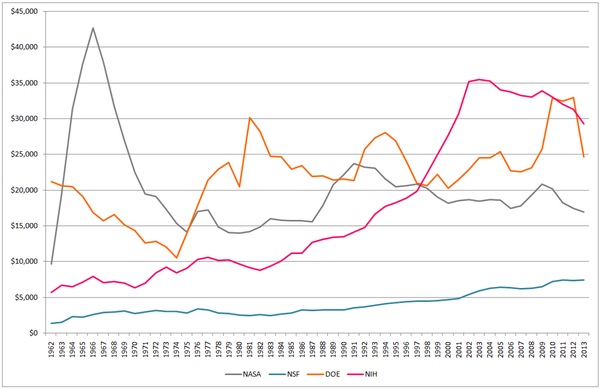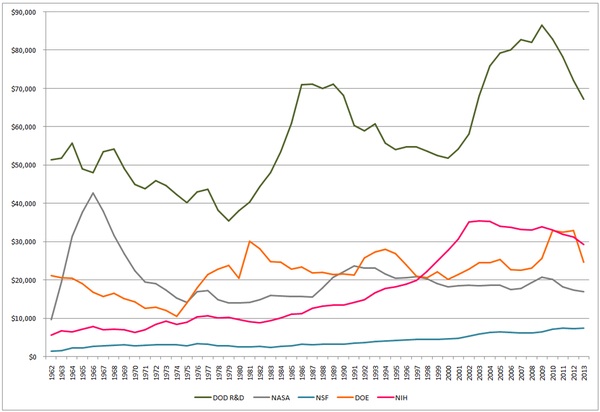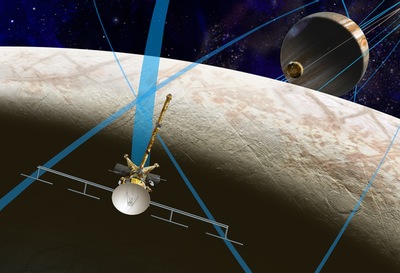Making the case for space science as a national priorityby Jason Callahan
|
| Understanding how national priorities have affected the resources available to federal organizations in the past demonstrates an often-unappreciated aspect of the budgetary challenges faced by the space science community, while also suggesting a possible strategy for addressing those challenges. |
This conundrum is particularly acute for individuals in professions whose activities are not measured by easily understood metrics such as financial return on investment or the number of citizens served. One such profession is space science. The value of space science is relatively easy to explain in the context of scientific activity (though some in the general science community still balk at the cost), but it is harder to quantify than the value of the Department of Transportation (DOT). Nor is the value as inherently easy to grasp as that of the Department of Defense (DOD).
Politicians and policymakers find it relatively easy to map the activities of organizations like DOT or DOD to a variety of national priorities, such as economic growth and stability or national security. This setting of national priorities is not necessarily a zero-sum activity, but the federal organizations that tend to receive the most stable levels of funding are generally those engaged in activities contributing to a variety of national priorities. Therefore, if the people supporting an organization are able to clearly explain how they contribute to an array of national goals, they position themselves more strongly to request federal resources for their activities.
Understanding how national priorities have affected the resources available to federal organizations in the past demonstrates an often-unappreciated aspect of the budgetary challenges faced by the space science community, while also suggesting a possible strategy for addressing those challenges. Following a brief discussion of the federal research and development (R&D) budget allocations since NASA’s formation, I propose a strategy that will provide scientific and technical communities with the tools they need to effectively demonstrate the contributions their members make to a broad number of national priorities. While I believe this strategy is likely effective for any of NASA’s science and technological communities, or any R&D community dependent on federal funding for that matter, I chose the planetary science community as my case study for a variety of reasons, including my familiarity with the community’s history, its relatively small size, and the fact that members of the community are easily identified.
National R&D priorities
National priorities are set and reset in a dynamic process. Sometimes making a topic a national priority for a time brings about some sort of resolution to the problem, but more often a new crisis arises that government representatives—and the constituents they serve—decide is more important than previous priorities.
Budgets are essentially a statement of priorities, so tracking the distribution of federal resources is one of the best indicators of our national priorities. Some priorities, like defense, education, commerce, scientific research, and international diplomacy, are broad in scope and represent ongoing and long-term investments. Other national priorities tend to be more reactionary, such as responding to international incidents, recovery from natural disasters, or even unintended outcomes of past policy decisions. This is an important distinction, because reactionary priorities are extremely difficult to plan for. I believe, however, that demonstrating an organization’s contributions to the broader priorities can greatly mitigate the impacts of the country’s shifting reactionary priorities.
The resources that government representatives allocate to broader national priorities tend to flow through a variety of institutions, and are often intended to address more than a single issue. That is, if education is a national priority, federal resources supporting this priority may flow to state governments to support schools and universities but may also pay for research into the most effective education practices, training for teachers, subsidies for tuition, training programs for displaced workers, and initiatives to increase participation in certain educational areas (like STEM education) or by certain groups. Reactionary priorities, by contrast, tend to garner resources that flow through a small number of agencies or a single organization, and usually for a period of years, not decades.
Below are a few historical examples that demonstrate how national prioritization affects resource allocation. NASA is one of the five largest R&D organizations in the federal government, along with the Department of Energy, the National Institutes of Health, the National Science Foundation, and the Department of Defense. These organizations receive the highest budgets in the federal government for science and technology research.
 Figure 1. NASA, NSF, Department of Energy, and NIH Outlays, 1962–2013 ($M, adjusted to 2013) |
Figure 1 displays the organizations with the largest research budgets in the non-defense discretionary line. The term non-defense means only that these budget lines are outside of the US defense and intelligence infrastructure, not that they are completely removed from any military application. There is, in fact, a fair amount of discourse between researchers in the civilian and military worlds, but that is outside the scope of this essay.
| However, while NASA leadership certainly intended after Apollo to build lunar bases and space stations, and expand further into the solar system, there were no plans outside of NASA for a continued human exploration effort. |
Figure 1 also provides a representation of the shifting research priorities for the nation over the last five decades. What I want to highlight in this plot is the common occurrence in funding federal R&D organizations in which budgets increase as a reaction to a new policy priority, but, of equal importance, then return to a relative state of equilibrium when priorities shift again. For those of us interested in the nation’s space program, it is important to understand the Moon race in this context.
In the 1960s, we can see the focus on the moon landing represented by a spike in NASA’s budget, shown with the gray line in the plot. Scientists throughout the United States had been pushing for the formation of a federal organization to continue activities like the International Geophysical Year (1957–58 and extended through 1959) on a sustained basis, but the Soviet launch of Sputnik and the later flight by Yuri Gagarin created a political opening. Public and government fears of a decline in U.S. technical capability drove the efforts to form NASA, based on national security and geopolitical concerns specific to the Cold War environment.
The race to the Moon, announced in 1961, was basically a crash project to demonstrate US technological superiority in a peaceful way. President Kennedy and his supporters in Congress intended for the Moon program to reassure NATO allies as well as non-aligned nations of US technical superiority. However, while NASA leadership certainly intended to build lunar bases and space stations, and expand further into the solar system, there were no plans outside of NASA for a continued human exploration effort. The Moon program cost more than the Manhattan Project and was one of the largest technical feats in human history, and when national leadership decided that the effort was complete, NASA’s budget settled out to a relative equilibrium.
NASA’s budget experienced another boost, albeit much smaller than the Moon race levels, in the late 1980s and early 1990s following the Space Shuttle Challenger disaster. This was a national tragedy, and building a new shuttle became a national priority, not just a NASA priority. The budget following the Columbia tragedy in 2003 did not increase as dramatically as it did after Challenger. At that time, Congress and the White House did not view construction of a replacement shuttle as a national priority, nor did they invest at a commensurate rate to replace the shuttle program. Aside from the Challenger replacement funds, NASA’s budget has remained comparably stable since the early 1970s, averaging just below (an adjusted) $20 billion annually.
In the 1970s, the country’s research focus moved toward energy, seen in the Department of Energy budget line represented in orange. This was in part a reaction to the 1973 oil crisis, resulting in President Jimmy Carter’s consolidation of a number of federal agencies into the Department of Energy in 1977 (the DOE budget numbers shown here come from the Office of Management and Budget’s historical data tables; numbers for the years prior to the agency’s formation reflect the combined budgets of the agencies absorbed into DOE in 1977). The additional rise of DOE’s budget in the early 1980s corresponds to the Reagan Administration’s policy increasing promotion of nuclear energy for power production, at least partially in response to the incident at the Three Mile Island nuclear facility in Pennsylvania.
We see other bumps in the DOE budget in following years, the results of the Clinton Administration’s increased investments in renewable energy research and the American Recovery and Reinvestment Act of 2009, which included significant spending on renewable energy and energy efficiency research. These later increases, which both returned to relatively stable levels in short order, are not as large as the ten-year rise in DOE’s budget from the early 1970s through the early 1980s.
Beginning in the 1980s and lasting for the next 20 years, the nation’s research focus shifted toward health and medicine, evident in the NIH budget line, magenta in the plot. The increase in the budget was actually due to a number of changes in national priorities over two decades. In 1980, Congress passed the Bayh-Dole Patent and Trademark Amendments Act, which loosened government holds on intellectual property rights associated with federally funded research, providing greater incentive for researchers to pursue federal sponsorship in a variety of fields. Congress did not target the medical field specifically, but since the act coincided with an increased interest from lawmakers in medical research, that is arguably where it had its greatest impact.
The NIH budget also increased in the 1980s in reaction to the growing AIDS epidemic, at first a politically controversial topic but one that eventually became a national priority. In the 1990s, NIH funding started to shift toward DNA research and the Human Genome Project. These are just examples of the many health priorities addressed by the NIH, but they represent how a national conversation can impact the allocation of resources.
As a point of contrast, the blue line representing the NSF budget in Figure 1 does not display the same type of dramatic shifts apparent in the other three budget lines. The NSF does not specialize in any particular discipline of research, but rather provides resources for basic or fundamental research in all non-medical science and technology areas. As a result, the organization is unlikely to find itself affected by a reactionary national priority, but certainly supports ongoing, long-term priorities. It therefore receives a relatively steady budget that experiences moderate, slow growth and comparatively few fluctuations.
| I think that the best approach for aligning activities of a research community with national priorities involves a broad strategy requiring a deep understanding of the community’s functions. |
Following the spike in each of the other three budget lines, which were the result of reactionary shifts in national priorities, the budget lines for each organization seem to level out a bit, give or take a few billion dollars. Focusing on the nation’s space program, this demonstrates that, barring a renewed interest in space as a national priority on the scale of the race to the Moon, NASA is unlikely to see a significant increase in its budget. And since the Moon race was the result of a specific set of events taking place during the Cold War, a far more likely scenario is that the projects and programs within NASA will continue to compete for resources that are set near the current levels. Again, give or take a few billion dollars.
 Figure 2. DOD R&D, NASA, NSF, Department of Energy, and NIH Outlays, 1962-2013 ($M, adjusted to 2013) |
As an interesting comparison, the plot above shows the Department of Defense R&D budget line, in olive, with the non-defense R&D agencies. Again, there are upward shifts during periods in which defense R&D spending increased as a national priority, particularly during the Reagan Administration in the 1980s and following the September 11, 2001, attacks. It is also interesting to note that the defense increase in the 1980s correlates with a decrease in Department of Energy spending, which had been on the rise through the 1970s. And again, the defense increase beginning in 2001 coincides with a downturn in spending on the National Institutes of Health, a clear R&D priority through the previous twenty years. This is not to say that federal R&D spending is a zero-sum game, but it does suggest the fluid nature of national prioritization and highlights to research communities the importance of aligning a community’s goals and activities with national priorities.
How does a research community align its activities with national priorities?
Whereas the examples above analyze vast budget lines and entire federal organizations, space science at NASA represents only one of the agency’s directorates, with planetary science an even smaller division within the directorate.
However, I think that the best approach for aligning activities of a research community with national priorities involves a broad strategy requiring a deep understanding of the community’s functions, and executing this strategy begins by examining smaller groups, or even subgroups, within a larger organization. The planetary science community is a relatively compact and discrete organization, representing an ideal test bed for this proposed strategy. If the strategy should prove effective for the planetary science community, I believe the methods could be replicated in other communities with equally favorable results.
The planetary science community over the last 50 years has become incredibly adept at positioning itself in the Washington budget debates in terms of science. The community effectively establishes goals through the Decadal Study process; its many component groups tend to stand unified behind its goals; and when provided adequate resources, it delivers world-class scientific research. And yet, the community is still subject to the budgetary constraints and seeming whims of shifting national priorities. Expanding the list of national priorities to which planetary science contributes will probably not alleviate this situation entirely. But I think it may be possible to mitigate the fluctuations somewhat, and establish a predictable range for planetary or space science budgets.
Clearly, it makes no sense for researchers to tailor all of their efforts to chasing reactionary national priorities, particularly when such shifts in policy are by definition dynamic and often unpredictable. The goals and activities of a research community are—and should be—driven by the scientific questions most relevant to that community. This does not mean that a research community can’t highlight aspects of its activities that already align to priorities outside of science.
As an example, the planetary science community includes a large number of highly specialized scientists, engineers, and technicians. These practitioners have acquired valuable skills they will retain regardless of their career paths. While many will continue to work in planetary science, aerospace engineering, or a closely related field, others will take their knowledge into other fields, introducing different thinking and techniques to their colleagues. Those who remain in the field will also disseminate new knowledge and ideas through collaborations, interdisciplinary work, and professional gatherings. More valuable than any technology or system that may be “spun out” from the space community, this circulation of ideas and practices is integral to the process of innovation upon which the US economy lies.
But to understand the full extent of the contribution to the US economy that members of the planetary science community make, we have to know some basic information: How many practitioners are there, and what are they working on? Where are they working, and with whom? How many teach or have students working with them? How many remain in their chosen fields and how many move to other fields? Perhaps most important, how do these numbers change over time and through varying historic circumstances?
| If planetary exploration is proven to impact many more national priorities than currently perceived by our political leadership, I believe it becomes much easier to argue for stable budgets even in times of fluctuating priorities. |
Mapping out these fluctuations over time, we could analyze qualitative changes made by US investment in planetary science contributing to national priorities, including STEM education at the university and post-graduate level, distributing knowledge through professional networks to foster innovation and commerce, engaging in international collaboration which bolsters goals of diplomacy and communication, and increasing skills and knowledge vital to our national defense capabilities. I think most researchers in the field know this intuitively and even communicate it implicitly, but we need the information to make such claims accurately.
Explaining the connections and details of planetary science community members to policymakers is key to demonstrating the impact of planetary science to a broad array of national priorities, but first we must have the data. So the first step is measuring the community in ways and at a level of detail not previously pursued. Understanding the state of the planetary science field in a holistic manner, particularly measured over time, offers immense analytical capabilities that will allow us to argue the significance of planetary science to national priorities beyond science, technology, and R&D.
If planetary exploration is proven to impact many more national priorities than currently perceived by our political leadership, I believe it becomes much easier to argue for stable budgets even in times of fluctuating priorities. And while I am confident the field of planetary science will reap tangible benefits from employing this strategy, I also believe that those benefits have the potential to increase significantly if the scope of the strategy is eventually expanded to encompass all of space science.
